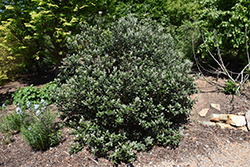It's all about ...
plants

Kawatiri Pineapple Guava
Acca sellowiana 'Kawatiri'
Height: 10 feet
Spread: 10 feet
Sunlight:
![]()
![]()
Hardiness Zone: 8b
Other Names: Feijoa, Guavasteen
Description:
A large evergreen shrub that can be maintained as a small tree, featuring gray-green leaves with white, woolly undersides; produces showy red and white flowers in spring, and edible, blue-green fruit in fall; a good landscape accent or hedge
Edible Qualities
Kawatiri Pineapple Guava is a large shrub that is commonly grown for its edible qualities, although it does have ornamental merits as well. It produces bluish-green oval fruit (technically 'drupes') with a red blush and creamy white flesh which are typically harvested when mature. The fruits have a sweet taste with a gritty texture and a pleasant fragrance.
The fruit are most often used in the following ways:
- Fresh Eating
- Cooking
- Preserves
Features & Attributes
Kawatiri Pineapple Guava features showy white pincushion flowers with fuchsia overtones and crimson anthers at the ends of the branches from late spring to early summer. It has grayish green foliage with white undersides. The fuzzy oval pinnately compound leaves remain grayish green throughout the winter. The fruits are showy bluish-green drupes with a red blush, which are carried in abundance from early summer to mid fall. The brown bark and white branches add an interesting dimension to the landscape.
This is a multi-stemmed evergreen shrub with an upright spreading habit of growth. Its average texture blends into the landscape, but can be balanced by one or two finer or coarser trees or shrubs for an effective composition. This plant will require occasional maintenance and upkeep, and is best pruned in late winter once the threat of extreme cold has passed. It is a good choice for attracting birds and bees to your yard. Gardeners should be aware of the following characteristic(s) that may warrant special consideration;
- Messy
- Spiny
Aside from its primary use as an edible, Kawatiri Pineapple Guava is sutiable for the following landscape applications;
- Accent
- Hedges/Screening
- General Garden Use
- Windbreaks and Shelterbelts
- Orchard/Edible Landscaping
- Container Planting
Planting & Growing
Kawatiri Pineapple Guava will grow to be about 10 feet tall at maturity, with a spread of 10 feet. It has a low canopy with a typical clearance of 1 foot from the ground, and is suitable for planting under power lines. It grows at a medium rate, and under ideal conditions can be expected to live for 40 years or more. While it is considered to be somewhat self-pollinating, it tends to set heavier quantities of fruit with a different variety of the same species growing nearby.
This shrub can be integrated into a landscape or flower garden by creative gardeners, but is usually grown in a designated edibles garden. It does best in full sun to partial shade. It does best in average to evenly moist conditions, but will not tolerate standing water. This plant should not require much in the way of fertilizing once established, although it may appreciate a shot of general-purpose fertilizer from time to time early in the growing season. It is not particular as to soil pH, but grows best in sandy soils. It is somewhat tolerant of urban pollution. Consider applying a thick mulch around the root zone in both summer and winter to conserve soil moisture and protect it in exposed locations or colder microclimates. This is a selected variety of a species not originally from North America. It can be propagated by cuttings; however, as a cultivated variety, be aware that it may be subject to certain restrictions or prohibitions on propagation.
Kawatiri Pineapple Guava is a good choice for the edible garden, but it is also well-suited for use in outdoor pots and containers. Its large size and upright habit of growth lend it for use as a solitary accent, or in a composition surrounded by smaller plants around the base and those that spill over the edges. It is even sizeable enough that it can be grown alone in a suitable container. Note that when grown in a container, it may not perform exactly as indicated on the tag - this is to be expected. Also note that when growing plants in outdoor containers and baskets, they may require more frequent waterings than they would in the yard or garden. Be aware that in our climate, most plants cannot be expected to survive the winter if left in containers outdoors, and this plant is no exception. Contact our experts for more information on how to protect it over the winter months.
This plant is not reliably hardy in our region, and certain restrictions may apply; contact the store for more information.
